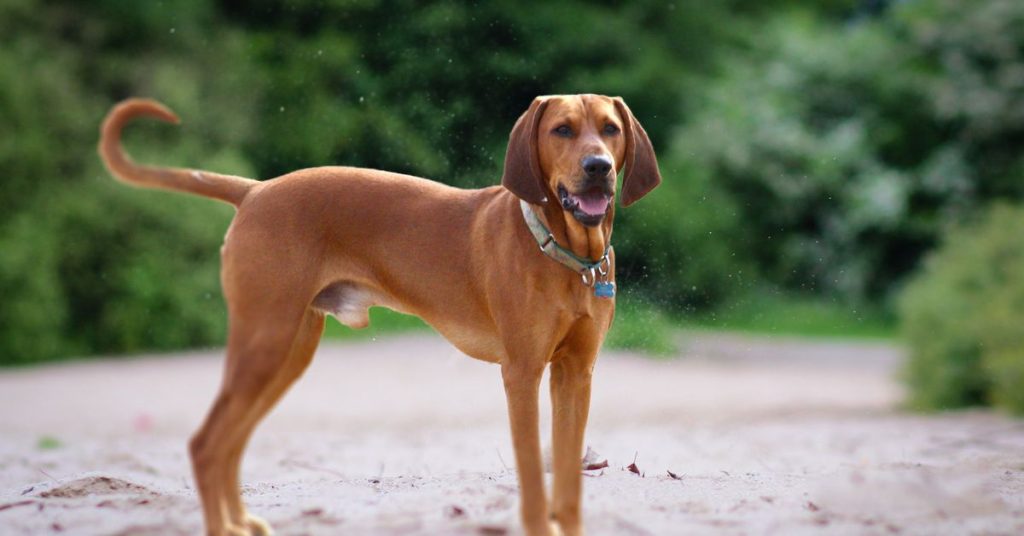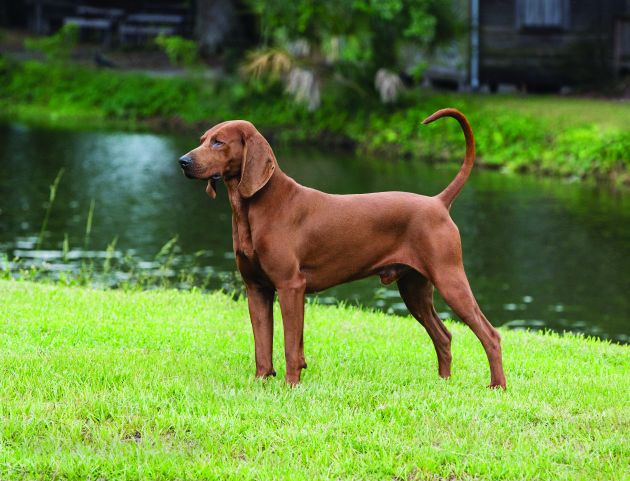The Redbone Coonhound is a tenacious hunting dog used for hunting raccoon, deer, bear, boar, cougar, or any other large game. The breed originated in the Southern United States and is highlighted by their deep red coat. Described by the American Kennel Club as having “an overall impression that a master sculptor carved them from blocks of the finest mahogany,” the Redbone blends an unrelenting hunter with a loving family dog.
History
In the early 19th century, Scottish immigrants brought red-coloured foxhounds to Georgia, which would later become the foundation stock of today’s modern-day Redbone. Around 1840, Irish-bred Foxhound and Bloodhound lines were added. The Redbone name comes from an early breeder, Peter Redbone of Tennessee, though the United Kennel Club credits Redbone’s contemporary, George F.L. Birdsong of Georgia, and Dr. Thomas Henry in the 19th century.
Over time, breeders followed a selective program that led to a coonhound that was adept at treeing wild-game up trees, was courageous against larger animals such as bear and mountain lions, agile enough to track in the mountains or in the marsh, and could swim if necessary (one of the few hounds with webbed feet). They are ideal for pack hunting of both small and larger prey. Originally, the Redbone had a black saddleback, but by the beginning of the 20th century, it was replaced by an uninterrupted red tone.
Like many American hunting dogs, especially those from the South, they were widely known by hunters and farmers, but not well-known in the show ring (the Redbone has since found recognition by the two major American kennel clubs). Because of its main use as a hunting dog rather than a show dog, Redbones are extremely rare dogs outside of the United States. There are very few breeders outside of North America and it is virtually unknown outside of the U.S.
Hunting

The Redbone is an extremely vocal dog. The breed is known for its distinctive “drawling” bark, also known as a bay. Hunters who use the breed follow the sound of the voice as the dogs’ track quarry. A Redbone Coonhound will have a “specific” bay when it has an animal either treed or cornered. This bay is very much distinguishable from their normal day to day baying.
Bred to work on all kinds of punishing terrain, Redbones are fast and surefooted and move with a proud, “swinging” gait. A Redbone Coonhound’s training is a key component to creating a capable hunting dog, so proper training should begin as soon as possible. The Redbone has a stubborn mindset that can work to the owner’s advantage, but the Redbone can also absorb a significant amount of information that can help with creating a reliable hunting dog. If properly trained, a Redbone Coonhound should never kill an animal it’s tracking. To discourage this behaviour, training a puppy with a weighted duck or waterfowl dummy can be used to discourage the dog from shaking the prey with its head.
Coonhounds are in the same group as well known breeds such as the Beagle, Basset Hound, and Bloodhound: they are bred primarily to track game using sight and scent over long distances. They are one of the few “cold-nose scent hounds,” or hounds that can accurately track and follow old scents. They also instinctively mark their position for following hunters by vocalizing as they catch up with their quarry. Therefore, this breed will have the desire to chase small animals such as rabbits, squirrels, badgers, or even cats. They are also adept in the water and can be compared to other water-loving breeds like the Labrador Retriever in swimming ability.
In a hunting setting, they will often make quarter-mile loops away from the pack searching for the scent of their prey before returning or using their bay to raise the alarm, thus bringing the pack to their aid. When breeding the Redbone Coonhound, traits such as determination and endurance created a dog that isn’t afraid to hunt until its exercise is accomplished. Because of their instinctive desire to follow scents, they are eager to follow their noses and may ignore their owners’ commands while in the field.
